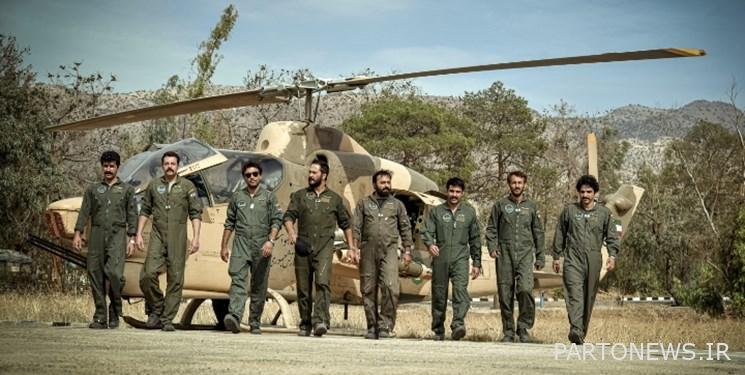Simorgh 42 | under the pretext of “the sky of the west”; A look at the endless treasure of “Sacred Defense Tales”

Fars News Agency-Cinema Group: Hearing the title of the holy defense cinema, leads the mind to clichés like the famous dialogue of the movie “The Last Identification”; “Kill Haji Seyyed!” This dialogue represents the feeling in the movies related to the years of the imposed war, which happened to be very important and valuable at one time, but it was repeated so much in different forms that it became an inhibiting stereotype for the audience to relate to the holy defense movies. This negative effect of stereotypes can appear in any genre, but it becomes more regrettable when rereading a huge sea of unsaid subjects in the heart of the memories and narratives of eight years of imposed war.
The movie “Asman Gharb” directed by Mohammad Asgari is one of the films that entered the 42nd Fajr Film Festival, which, centered on martyr Ali Akbar Shiroudi, has portrayed a new part of the untold stories of the war on the screen. Under the pretext of reviving the cinema of the holy defense with films like this, we have gone to review the most prominent non-stereotype films in this genre over the past four decades.
60th decade; Seeing differently in the shadow of war
Iran spent a major part of the 60s under the heavy shadow of war, and naturally Iranian cinema could not be affected by it either. By the way, one of the reasons why the cinema of the Holy Defense became the only native genre of Iranian cinema in the following years was its maximum influence. Even though the dominant current in the narrative of the war in this decade was based on stimulating and motivating the audience, and for this reason stereotypes were highly powerful in the works of this field, there were also prominent directors who narrated the war from a different angle. From Bahram Baizai, who in 1964 shot the film “Bashu Gharibeh Kochoch” focusing on war refugees, to Ebrahim Hatamikia, who tried to overcome the appearance of “war” with two works of his career, “Dideh Ban” and “Mahajer”. He did and depicted the interior of what he considered “sacred defense” with a poetic language. In the same decade, a filmmaker with another style, such as Rasul Malaqlipour, tried to present a part of the history of the war in the form of hero-centered stories in the form of “Blami to the Shore” or “Afq”.
the 70’s; Not everything is front line
At the beginning of the 70s, Kianoush Ayari, with an anti-war perspective, went to the victims of the imposed war and directed the film “Abadaniha”. A film that was misunderstood and banned due to its opposite view. This is the same decade that the war ended and the process of returning to normal life in the country was keyed, but cinematographers are still trying to retell this bitter experience in their different ways. Step by step, Rasul Malaqlipour finds a more poetic and metaphorical look at the holy defense cinema and creates bold works such as “Journey to Chezabeh”. Kamal Tabrizi, who was one of the pioneers of Iranian cinema in the holy defense cinema, for the first time in this decade, went to the war with a comedy tone and directed the movie “Lily Ba Man Is”. Despite all this, in the 70s and in the years of returning from the front to the city, it is Ibrahim Hatamikia who is the standard bearer of pure ideas in the holy defense cinema. From “Vasl Nikan” to “From Karkhe to Rhine” and from “The Smell of Yusuf’s Shirt” to “Glass Agency”, this director has never succumbed to stereotypes. Even in unsuccessful experiences such as “Mino Tower” or “In the Name of the Father” we can clearly see this struggle to go to the unspoken things of war.
the 80s; A light is still on
Although in re-reading the current of holy defense cinema, we usually consider the 80s as the decade of forgetting and neglecting this genre, and few indicators show that other filmmakers had less desire to make films related to war, but in this same decade, we still see the recording of valuable experiences. Behzad Behzadpour directed the lasting film “Goodbye Rafiq” on the eve of the 80s. Although the film was abandoned in the year of its production, it was not seen well, but after two decades, many consider it to be one of the prominent experiences of the holy defense cinema. At the same time, Ahmadreza Darwish, who has been the standard-bearer of war history narrating on the cinema screen, approached the difficult film “Duel” with a very different idea and narrated part of the unsaid war in his story with a metaphorical language. Rokhshan Bani-e-Etemad is considered one of the leading women in Iranian cinema, who portrayed one of the most shocking narratives of the heavy shadow of the consequences of war on the lives of ordinary people in 1983 and in the lasting film “Gilane” with the admirable role of Fatemeh Motamedarya. Even a director like Kyomarth Pourahmad in the middle of the 80s with Habib Ahmadzadeh as a screenwriter, recorded a different story about the presence of a teenager in the war in the movie “Night Bus”. One of the bold filmmakers of the holy defense cinema, who has not and does not shy away from touching hot topics in this genre, but we should mention Mohammad Ali Basheh Ahangar, who first came to the idea of trading with the bones of the investigated martyrs in “Farzan Khak” and then continued with this different approach. continued in “Awakening Dreams” and “Queen”. Shahram Esadi was one of the filmmakers who, in the late 80s, was able to bring one of the unsung heroes of the Holy Defense years, Martyr Daryagholi Sorani, to life on the screen with “The Night of the Event”.
the 90s; Freshers went to the unsaid
Holy defense cinema got a new life in the first half of the 90s with the arrival of young filmmakers. In 1994, it was Mohammad Hossein Mahdovian who went for a documentary retelling of the life of Haj Ahmed Metouslian and sent the admirable film “Standing in the Dust” to the screen with a highly anti-stereotype expression and structure. It is in this decade that female filmmakers also enter the field, Narges Abiyar directs “Shiar 143” and Mounir Ghaidi goes for “Vilaiha” and “Girls’ Group”. From the point of view of production, war cinema is also becoming more professional, and Bahram Tavakoli depicts a breathtaking narrative of epic creation on the battlefield with “Abu Gharib Strait”. In the 1990s, there is less evidence of the old stereotypes regarding the holy defense, and this change of view continues until the early years of the 1400s. At the same time, Hadi Hejazifar directed the admirable film “Mahdi’s Situation” to bring the image of a believable hero named Mehdi Bakri to the cinema screens. War heroes are now more than ever in the spotlight, from “Mansour” and “Gharib” to “Majinun” and “Asman Gharb”, now Iranian cinema is de-stereotyping the image of the myths of sacred defense.
“Western Sky” and an untold narrative
Many holy defense films have tried to narrate the effects of war on people’s daily lives, and besides portraying the epics in the field, they have also had a partial view of the normal flow of people’s lives. “Asman Gharb” goes beyond cinematic stereotypes, but from a historical point of view, it has tried to go to a neglected period in the history of war. In the first two to three days after the Iraqi Baath forces attacked Iran, Ali Akbar Shiroudi along with a small number of his companions in the air force did not obey the orders of “higher” and preferred to disobey them! This disobedience to a military order has a tremendous impact on the ongoing developments of the war, and Mohammad Asgari has tried to depict these fiery days in his film. “Asman Gharb” is one of the products of Sourah Cinema Organization, which, in addition to Martyr Shiroudi with the role of Milad Kimram, has also paid tribute to other important figures such as Martyr Adabiyan, played by Amir Hossein Arman, and Haj Hossein Hamdani, played by Armin Rahimian. The eight-year history of the imposed war still has many stories of this kind.
end of message/
You can edit this article
Suggest this article for the first page

